Lüderitz is a coastal city that was created from the diamond fever that took place in the late 19th century. This town is located in the south of the Namib Desert, and to get there you will have to cross different dunes on both sides of an asphalt road. On windy days, sand is likely to occupy part of the road pavement.
This small German colonial town is called Lüderitz in honor of the first German to arrive there, around 1883. Adolf Lüderitz started a factory with fishing and guano harvesting in this area. So, he bought the land from the local tribes who were the namas. Lüderitz bought a plot of land of about 4.000 square kilometers (80 kilometers inland and 50 kilometers of coastline) from the namas for about 100 pounds and 200 guns.
From there, a city with a large presence of German emigrants was created and became the main city of the Colonial Company of Southwest Africa in Germany. In 1909, after the discovery of diamonds in this area, Lüderitz became very popular. There were many diamond miners who came to live in this area which was very rich, where minerals could be extracted without almost digging. In fact, a village called Kolmanskoop was created near Lüderitz, which was one of the focal points of diamond mining in the area. Today, however, it is a ghost town, abandoned, very interesting to visit to know the history, the houses as they were, the hospitals… Being next to the desert, the sand has taken over some of the buildings, which makes this town a very photogenic place and a must stop if you are in the area.
With the discovery of new places with more valuable diamonds such as, for example, in North South Africa; many of the former inhabitants of Lüderitz and the surrounding area left. With the independence of Namibia, this diamond zone came to be controlled by a company in which the Namibian government is the largest shareholder with 51%, and the other 49% is in the hands of De Beers, a of the world’s largest diamond companies based in Canada.
Today, Lüderitz is a quiet town, with about 14.000 inhabitants where most of the economy wealth comes from fishing. Most of the inhabitants there work for large fishing companies, such as the Spanish Pescanova with processing plants with a capacity of 100 tons per day, one of the most important fishing power plants they have in the south of Africa. However, this city is also notable for its architecture with colorful buildings from the German colonial era.
Around it, you can also discover a beautiful peninsula that is right next to the ocean and where you can find African penguins (if you want to know more about this curious animal, you can click here), as well as jackals, birds and hyenas; among others. There you will also find Dias Point, the place where Bartolomé Dias (one of the most important explorers of the 15th century and who was from Portugal) arrived in 1488 in search of a sea route between Europe and Asia. In fact, a replica of the cross erected by the Portuguese as a symbol of Christianity can be seen.
The Lüderitz area is a fairly remote area of Namibia, located in the south of the country, which was a very important place for diamond mining, but which has now become one of the most important fishing centers in the country, with a coast and a very interesting peninsula to discover, as well as mining ghost towns to photograph and wildlife to look for like the few wild horses left in this area. A very interesting visit if you have time to discover this vast country that is Namibia.
How to get there?
The city of Lüderitz is located on the southern part of Namibia’s Atlantic coast. Further north of the city, we find the Namib Desert, one of the oldest on the planet (if you want to read our experience there, you can click here); and further south, diamond reserves that are impossible to access as they are controlled by private companies. Therefore, there is only one way to get there: drive along the B4, a paved road where if the wind blows you will sometimes find sand from the dunes on the route, until you reach Lüderitz. From Keetmanshoop to Lüderitz there are about 340 kilometers on a good road that you can do in 3 hours.
If you come from the north, such as Sesriem, you do not need to reach the town of Keetmanshoop. You can take the C27 south to the town of Helmeringhausen, and from there take the C13 to Aus, where you will find the B4 which will take you to Lüderitz. From Sesriem to Lüderitz, it takes about 6 hours, most of which will be on a gravel road until you reach the B4. Make sure to fill your tank with fuel, as you will only be able to refuel in Lüderitz.
12 km before reaching the town of Lüderitz, you will find on your left the ghost town of Kolmanskoop, one of the must-see stops if you visit this area. If you want to visit one of the viewpoints to see wild horses in the wild, they are about 105 km away before you reach Lüderitz. You will find the turnoff on your right, from where you can get out of the car and go to a lookout to see if you are lucky and you can see these animals in complete freedom.
On the other hand, if you want to get to the Lüderitz peninsula, you have to get to the Burenkamp train station, which you will find on the left turn just after passing the Engen petrol station at the entrance to the city. From there the road begins with different itineraries to access the different points of interest of the peninsula.
What to do in Lüderitz?
Lüderitz is a quiet town which is very isolated as you will need to travel a long way to get there. In any case, it has created a very powerful nucleus with the local inhabitants who live there, mostly workers of the fishing companies. The main activities we recommend if you visit this area are:
– Visit the village of Kolmanskoop, a ghost town that is increasingly occupied by desert sand
Kolmanskoop is arguably the most photogenic village in Namibia along with Solitaire (if you want to read more about this place, you can click here) and the Stone Men, mysterious stone figures found in northern Namibia (for more information about these sculptures, you can click here). It is a ghost town where no one currently lives and has been turned into a museum to tell the recent history of diamonds in this area, which turned this village into one of the nerve centers of Namibia in the 20th century.
Today, it is a very photogenic village due to the sand that has been entering the abandoned houses. You will find rooms full of desert sand, as well as semi-buried houses, baths on dunes and a unique and curious landscape that make it the most visited place in Lüderitz. Many years from now, this village will surely end up in the sand of the desert.
In fact, the name of the village also has its origins in a sandstorm. It was in 1905 when a transporter named Kolmans came from Keetmanshoop, and just before he reached Lüderitz, a storm stopped him on the side of the road where he had been for some days. That little mountain created by the storm became known as Kolmanskoop (Kolmans mountain in Afrikaans). One year later, in 1906, a German from Kimberley (one of South Africa’s richest diamond regions) discovered a diamond-filled area on this small mountain, and decided to buy the land without saying anything to anybody. This is where the diamond fever began in Kolmanskoop, with the creation of a village out of nothing from 1909 and a railway route connecting Aus with Lüderitz and built in 1910 in a period of only 10 months.
Until the First World War, this town lived its maximum splendor as diamonds were found very easily. There was a 250-bed hospital, buildings for merchants, a bowling alley, a saltwater pool, single homes, and miners’ homes. There was a total of about 1.000 people, 300 of whom were Germans while the rest were local diamond miners who received ration cards to cover basic needs.
During World War I, many of the Germans left for their country, and, a few years later, many of them moved to Richmond, a city in central South Africa where in 1927 were discovered diamonds that were seven times more valuable than Kolmanskoop ones. The village was losing population until 1958, when the hospital closed permanently and the village was completely abandoned.
During all these years, from the erosion of the sand and the wind, this village has become a unique place with rooms full of desert sand and some buildings such as the hospital, the bowling club and the theater that still keep as they were. We recommend that you visit this place based on the guided tours that take place every day at 09.30 am and 11 am from the theater located in the center of town, so you can learn more about the history and the curious anecdotes from this place. Visits are in Afrikaans and English, and are included in the ticket that you will pay when you enter the village from the B4. Entry fee is 100 NAD per person (about 6 euros), to be paid in cash.
Kolmanskoop is a village located about 12 km from Lüderitz, where you can create a very original photo album while discovering the recent history of one of the country’s iconic places, which was created from scratch and made a fortune. during the diamond fever of the late 19th century, but which today has been partly buried by the sand and his past.
– Stroll through the city and have lunch at The Portuguese Fishermen
Lüderitz is a town located right on the Atlantic coast. Like most maritime towns, one of the activities we consider most beautiful to do is a walk through its streets and also outside its port, where you will see all the commercial activity but where you can also find the local population, many of which they are workers of fishing companies.
One of the highlights of the city of Lüderitz is its colonial past in the hands of Germany. In fact, this city was one of the most important of the so-called Colonial Company of Southwest Africa in Germany, and proof of this is the architecture of the city that lies within the route of the European route of modernism, and that includes some expressions also of the Art Nouveau. When you walk through this city, you will feel that you are not in Africa, but in a traditional village in northern Germany. The Goerke House (1909) is one of the most popular buildings in Lüderitz, as is its neo-Gothic church Felsenkirche (1908) right next to the sea, the Deutsche Afrika Bank or the museum in the old railway station.
Finally, if you are hungry, Lüderitz is a great place to try local fish from the area. There you will find different restaurants, among which we highlight The Portuguese Fishermen, a place by the sea led by a man of Portuguese origin (Joel) and who will prepare different fish and seafood dishes for you. This restaurant is closed on Mondays. For more information, you can contact Joel directly at +264 81 147 8347.
– Drive through the Lüderitz peninsula, stopping at the different viewpoints in front of the sea as well as observing the different wildlife in the area
To the south of the town of Lüderitz, just a few kilometers from the center, you can enter its peninsula which is characterized by being completely by the sea and having different points of interest where you can observe wildlife such as African penguins, jackals or hyenas; as well as viewpoints, pristine beaches, lighthouses and points of interest such as Dias Point. The fact of being in such a remote place with few people makes this peninsula a very special place to enjoy a night of wild camping by the sea, as well as savoring the solitude of this place surrounded by ‘a very beautiful landscape.
For lovers of ornithology, the coastline of this whole peninsula is recognized by Bird Life and other global conservation groups as one of the Important Bird Areas (IBA) in the world, with a significant reproduction of waterfowl, where, for example, almost a quarter of the reproduction of the crowned cormorant is also found on this peninsula.
Below, we highlight the main points of interest on the peninsula that we visited and that we liked. In some of these places we found animal life (although we did not see hyenas), and in others a beautiful landscape by the sea. These are:
– Halifax Point: This spot next to Dolphin Beach (where you can sometimes see dolphins) and very close to Dias Point is one of the places to go if you want to see Namibia’s largest population of African penguins. In fact, it is one of the few places in Africa where you can find this very special animal, along with Boulder’s Beach in South Africa (if you want to read our experience there, click here). You can walk along the beach until you see the penguins that are usually found in and out of the water on the small island in front of Halifax Point.
– Dias Point: At this point, a few kilometers from Halifax Point, is where the Portuguese explorer Bartolomé Dias stopped on 25th July 1488 when he was returning to Portugal after exploring a sea route connecting Europe with Asia. To immortalize this moment, they placed a wooden cross in honor of St. James to celebrate the day of his Saint. Today, you can see a metal replica of the cross, as well as the lighthouse that opened in 1915.
– Grosse Bucht: This point is a bay located in the south of the peninsula with a wild sandy beach where you can walk if the wind is not strong. In that area, you can see many waterfowl such as flamingos, gulls, pelicans, cormorants… and a small boat that sank in that area in 1978.
– Kleine Fjord: This is where we spent the night with our car. It is located just above Grosse Bucht, in a space where you are better protected from the wind. You will be able to climb the rocks and see a beautiful rocks arch and enjoy a fantastic sunset. During the morning, we saw a family of jackals on the beach looking for marine animals to feed on.
To enter this peninsula, you do not have to pay any entrance fee and you can travel by car following the directions you will find along the way. Anyway, we recommend that you follow Maps.me because the paths there are very well signposted. It is also a good place to wild camp, as you are completely surrounded by the soundtrack of the waves, the desert landscape and the human solitude uninterrupted by the diverse animal presence in the area. If you are camping, think about leaving the area clean when you go out and not leaving food outside during the night because most likely the next day, some jackal or hyena will have eaten it.
– See, on the way to Lüderitz, the famous Namib wild horses
One of the main attractions you can see on the way to Lüderitz is the wild horses of the Namib. It is amazing how you can find these animals in the arid areas of the desert. The main viewpoint where you can go to see if you are lucky enough to find them is about 105 kilometers before you reach Lüderitz, where you will find a wooden structure to sit and observe these animals in the vastness of the desert.
Extensive research suggests that the ancestors of these horses were released about 100 years ago and went to live in the desert, far from any human civilization. Today, these horses are already part of the Namib ecosystem, where they live in a wild state without being domesticated in any way, just like other animals such as antelopes. There are currently around 100 species that you can find during your trip to Lüderitz and near the town of Aus.
Where to sleep in Lüderitz?
We, when we slept in Lüderitz, did wild camping on the peninsula and without paying in some of the natural spaces you will find in that area. Therefore, we cannot recommend first-hand accommodation. What we can recommend is that you spend a night on the peninsula because it is a very beautiful place. If you are looking for accommodation in the city, however, we would highlight:
– Lüderitz Backpacker Lodge: Located in the city center, this old establishment offers rooms, camping space, common areas such as shared kitchens, wifi, parking and a very nice atmosphere. For more information, click here.
– Tranquility Guest House: This accommodation offers different types of rooms in the city center, within walking distance of all the iconic points of Lüderitz. It has wifi, and has a very good Google score for the customers who have slept there. For more information, click here.
– Lüderitz Nest Hotel: This is one of the most luxurious accommodations in the city, located next to the Felsenkirche, on the seafront and also with views of the peninsula. It offers different types of rooms, a private beach, a swimming pool and a wooden deck, among others. It is an accommodation for high-budget travelers. Room prices range from 100 euros per person per night. For more information, click here.
Our route
DAY 1: After getting up in exceptional accommodation such as the Fish River Lodge, and saying goodbye to the second longest canyon on the planet, we had to head towards the B4 and then go straight to the coast and discover the area of Lüderitz. The route from Keetmanshoop to Lüderitz runs along a very paved road where on the horizon you see an arid and desert landscape that is becoming more and more dune-shaped, with sand that already occupies part of the road and, sometimes it crashes against the car window. Before, however, we stop at Aus to see the lookout of the wild horses. Unlucky, we didn’t’ see them. There were only four ostriches in the middle of the desert.
We arrived at Lüderitz where we left the car at The Portuguese Fishermen, the place where we would have a good seafood. We took advantage of the fact that there were still a few hours left for lunch to walk around the city, visit the neo-Gothic church, look for a local SIM card on our phone and walk the quiet streets of this town, which seems un-African and, instead, very German for the architectural structure of the city.
After getting hungry, we went to the restaurant where we met a French man who is engaged in the fishing business and we met Joel, the owner of the restaurant, who told us that in Lüderitz there was a strong presence of Spanish people due to the presence of the Pescanova processing plant. There, we tried a cataplana of fish (a typical Portuguese dish), accompanied by very tasty good seafood. It was noticeable that we were in a sea area!
After lunch, we took another walk through the harbor, where a strong wind blew which made the waves quite swell. In the afternoon, we took the car and went around the Lüderitz peninsula, looking for a place to sleep that was protected from the wind, and taking the opportunity to visit the different points of interest that we had marked on our map.
Our surprise at starting to drive on the roads of the peninsula was the loneliness we encounter. There, we found no one except some antelopes that ate quietly in the distance. We stop at Grosse Bucht Bay, where the wind blew too hard to set up our tent; so, we went up, discovering new points such as Halifax Point, where we could see a colony of African penguins. We approached them and also saw if we could see dolphins, although with the force of the wind, the presence of these animals became almost impossible.
The next stop was Dias Point, where we walked to the point where explorer Bartolomé Dias arrived. The coast was completely wild, with a replica of the cross placed by the Portuguese placed in the same place. It was amazing to be in places where explorers came hundreds of years ago, and to see that the place has changed very little; with almost no architectural presence except for the lighthouse and the small restaurant next door.
We went to the other side of the peninsula, trying to cross directly on sandy roads … But, on a steep climb on off-road roads we disregarded it and return to the main road to find a place to camp before the sunset. The best place to protect ourselves from the wind was at Kleine Fjord.
We got there and parked the car so that the wind got as low as possible… We set up the tent, and we went to see the sunset from the rocks, passing by a very beautiful arch of rocks. Once past the rocks, we found ourselves in front of the vastness of the ocean, with the waves crashing against the rocks, the endless noise of the water and the two of us alone on the peninsula. A very beautiful sunset during our first day off the coast of Namibia.
DAY 2: Today we got up with the first rays of sunshine. The night had been less severe than we expected and the wind seemed to have calmed down a bit. We were getting ready for breakfast and tidying up the tent when suddenly on the beach in front we saw two jackals running towards the rocks, in the opposite direction from where we were. Really, they were very close to us, and we didn’t even realize it.
We pick it up and when we opened the car, we saw small jackals coming out of the grass and getting scared for the engine noise and running to where their mother was. We entertained ourselves by watching this little family of jackals that we had been lucky enough to have been with us.
We left the peninsula after enjoying its solitude, its landscapes, its fauna and its strong wind. It was time to explore one of Lüderitz’s iconic places, such as the ghost town of Kolmanskoop. Since we didn’t know if the guided tour would start at 9am or 9.30am, we arrived early and waited for the main theater. We took the opportunity to visit some of the abandoned houses for ourselves, with some of the rooms full of sand. It seemed a lie that there was life there only 70 years ago, but now it is practically occupied by the sand of the desert.
Other cars were starting to arrive and we all got together at the theater. We would be guided by Ramon as a guide, a very nice guy who did the tour in English. With him, we visit some of the most important points of the village such as the bakery, the bowling alley or the grocery store, while he told us anecdotes of the ghost town. Like, for example, a German who painted the wall with a tropical landscape to show that he was not in the middle of the desert. Kolmanskoop was a totally nerve-wracking spot and has now become a totally nostalgic spot for many people in the Lüderitz area.
Once we finished the guided tour, we had all the time to discover corners of this ghost town. We enter the houses as if entering without permission, approaching the different rooms and observing how the sand has become more and more present filling the empty spaces of the stairs or some balconies. It was time to open our creativity and took different photos of this curious place. We continued quietly through the different houses, found a bathtub in the middle of an empty room and took some funny photos, and finally enter the hospital. It was shocking to get inside those walls, with very long corridors and doors on either side that used to welcome the sick, and now, on the other hand, they are very empty of people and full of sand…
We were amazed at the history of Kolmanskoop, as well as its landscape. We don’t know if this village will still be there in 50 years or if it will end up buried under the desert as if it were an ancient swamp-covered village. But thanks to the work of guides like Ramon, this place, despite being abandoned, is still alive and is one of the must-see stops if you visit Lüderitz.
We continued on to the Namib Desert, in Sesriem, where we wanted to relive the petrified dunes and trees of Deadvlei. However, in one day was impossible to arrive, so we did wild camping in our way to Sesriem. Before that, however, we stop at the Wild Horse Lookout and, yes, we were very lucky. In front of us was a small family of four horses that, after drinking water, was once again moving away to the greatness of the desert. Really, they were horses but as they act, we could see that they were not domesticated. One did a small leap, and the others advanced in a row while we took the opportunity to enjoy the famous wild horses of the Namib.
After such a busy day, we found a small place hidden from the road behind a large rock where we could leave our car, prepared the dinner and set up our tent and did, again, wild camping in Namibia for another night. In this southern part, we felt completely isolated, without crossing any car and without the presence of human life. Just us and the animals in the distance, enjoying the here and now. Namibia is a spectacular place for wild camping. Good night!



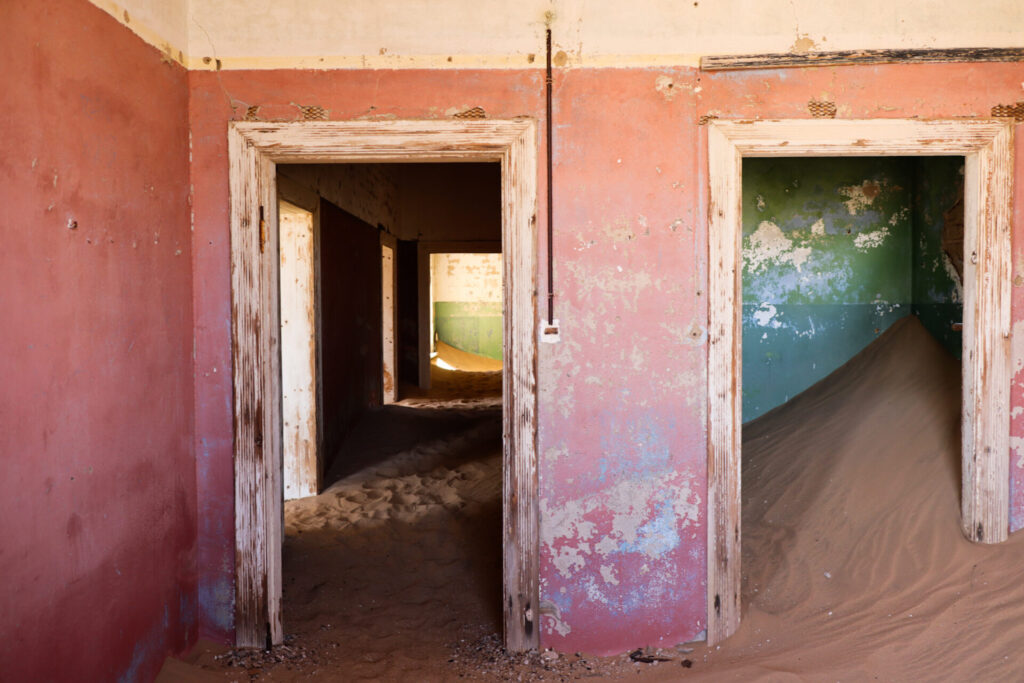

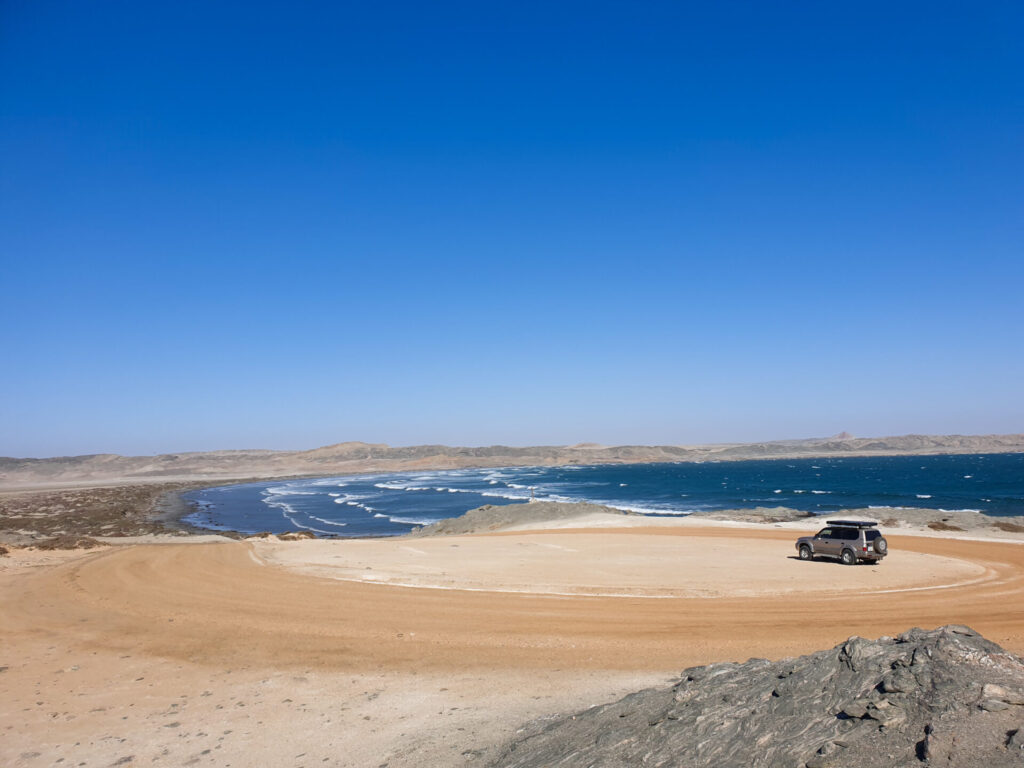


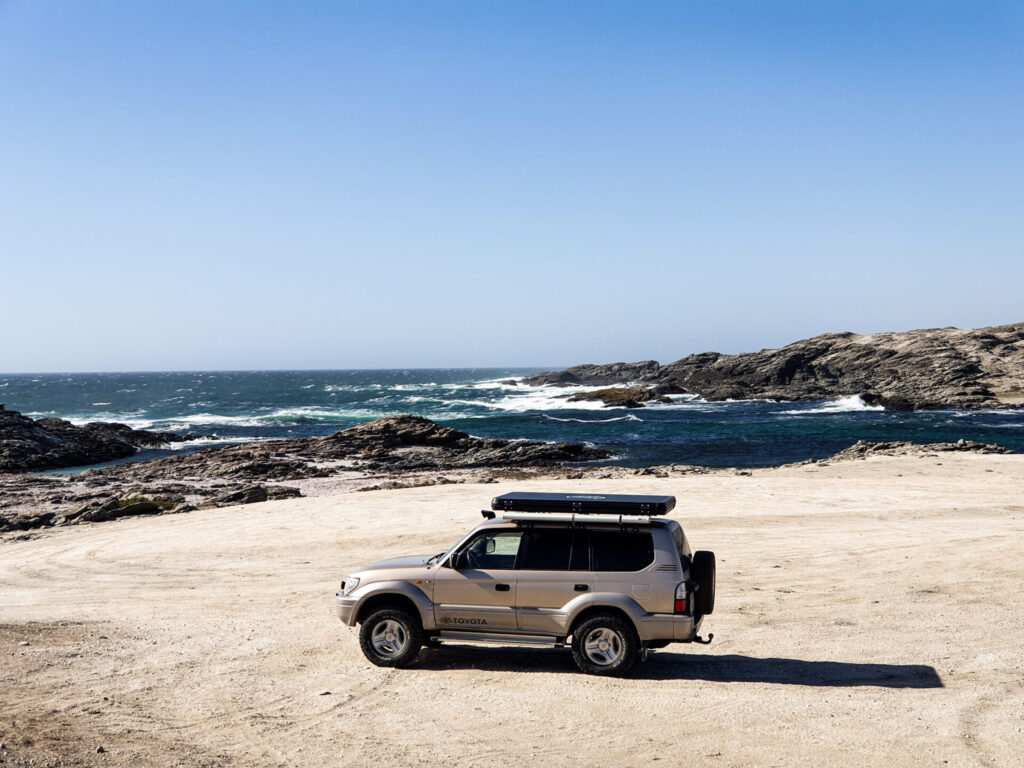
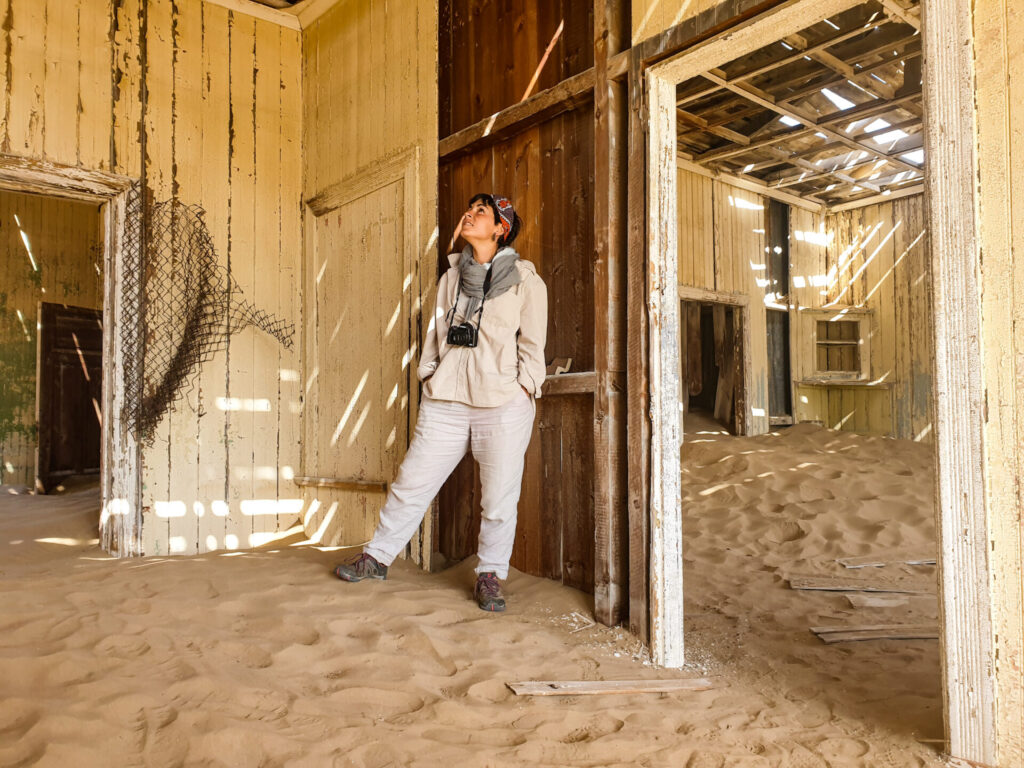
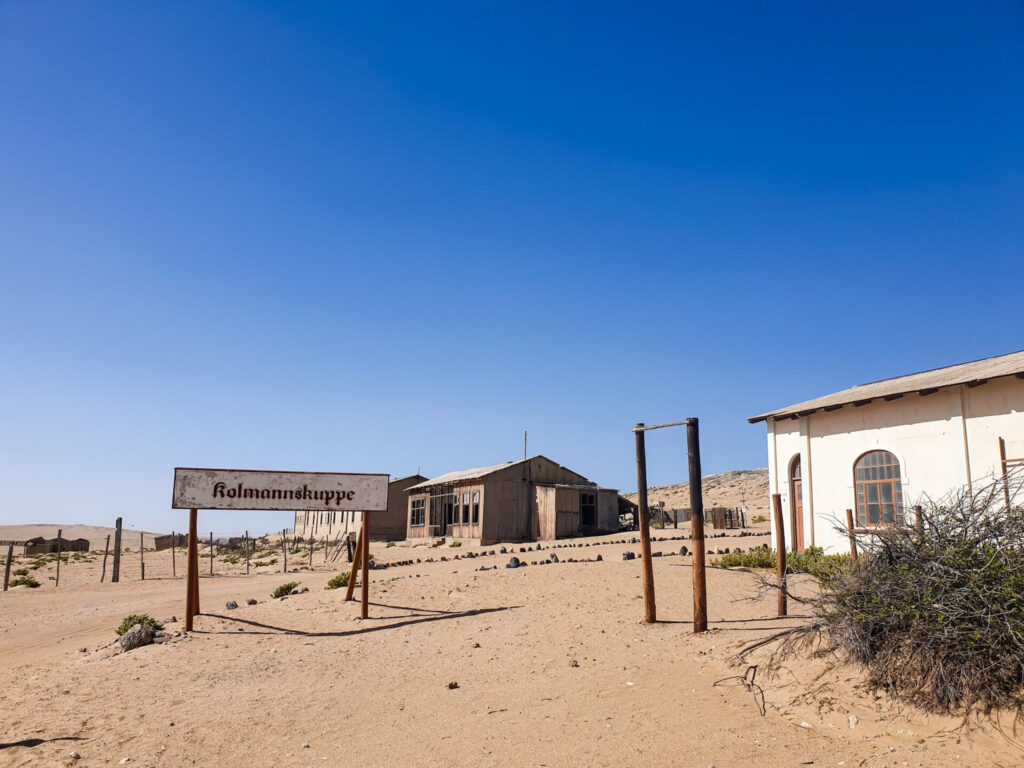




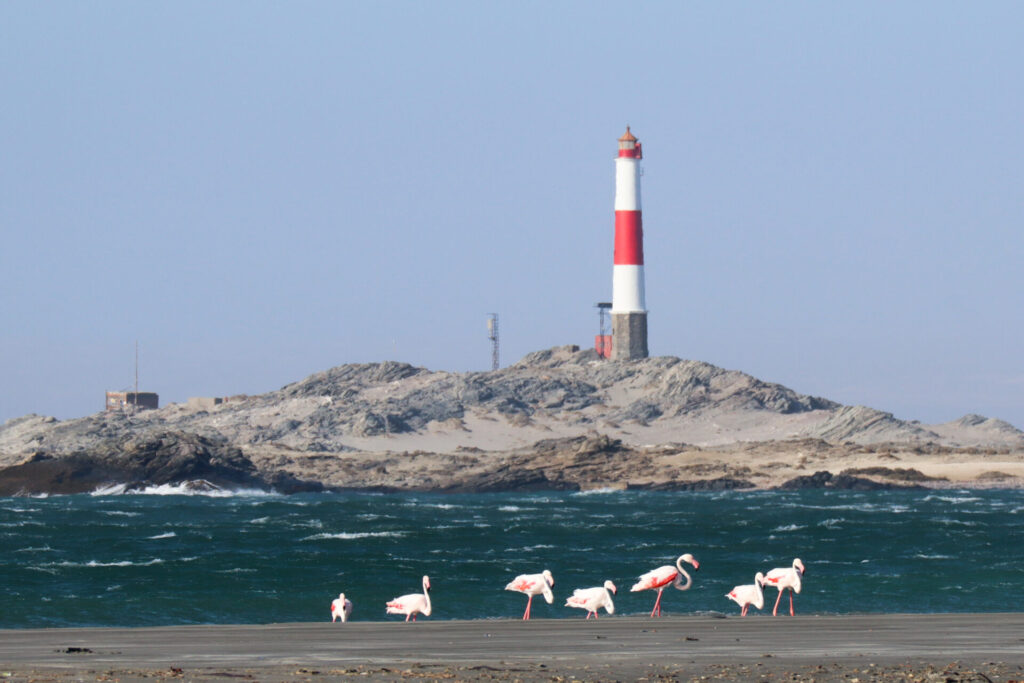
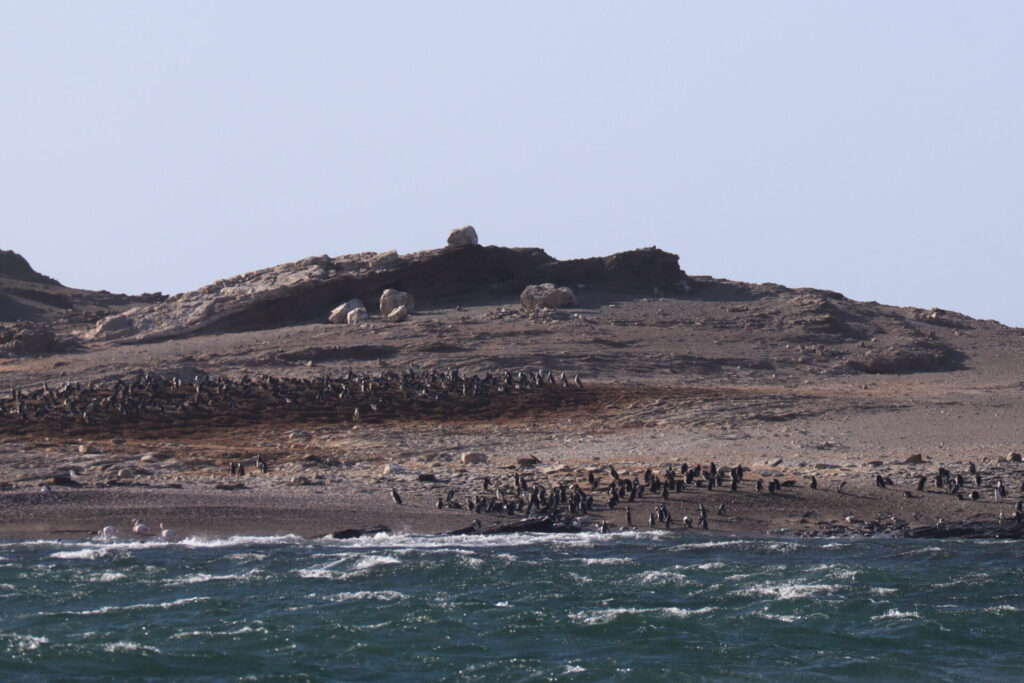


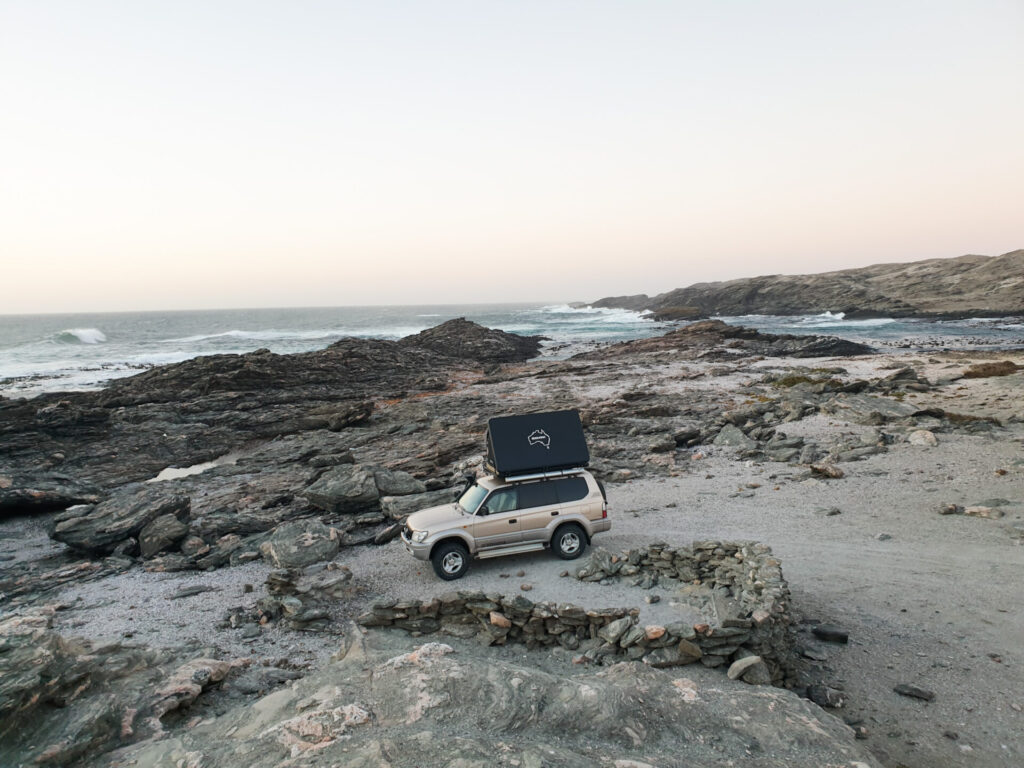

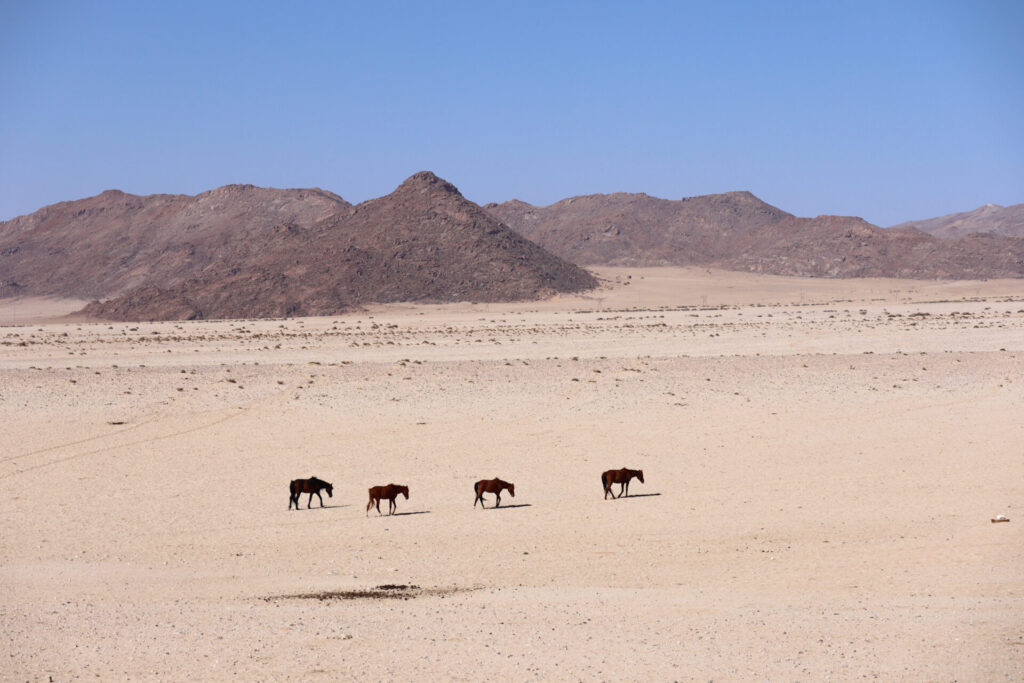

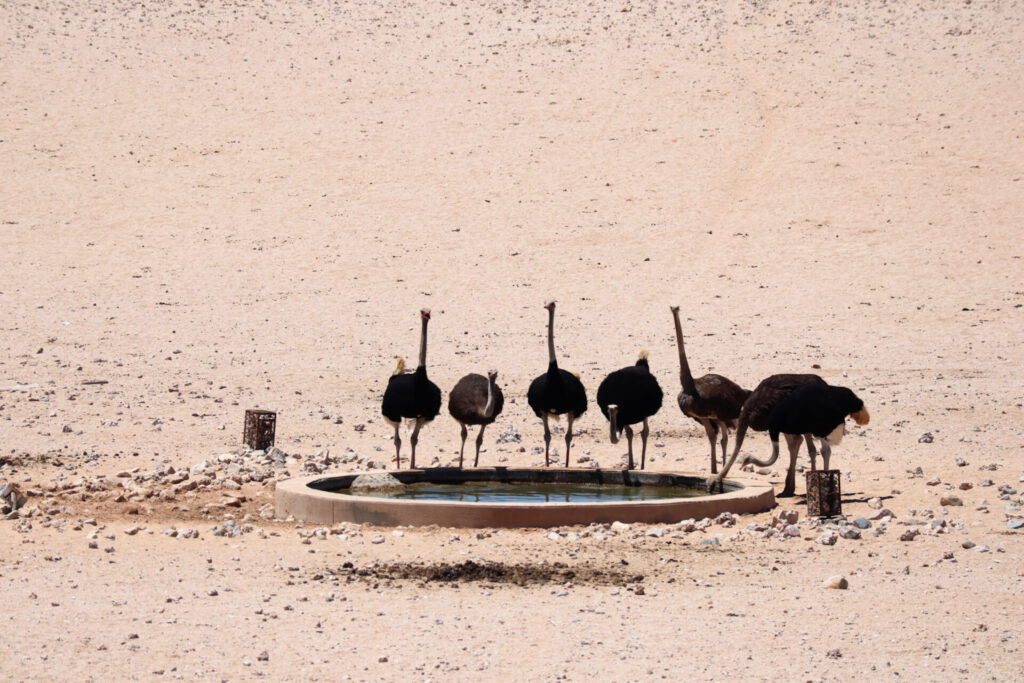
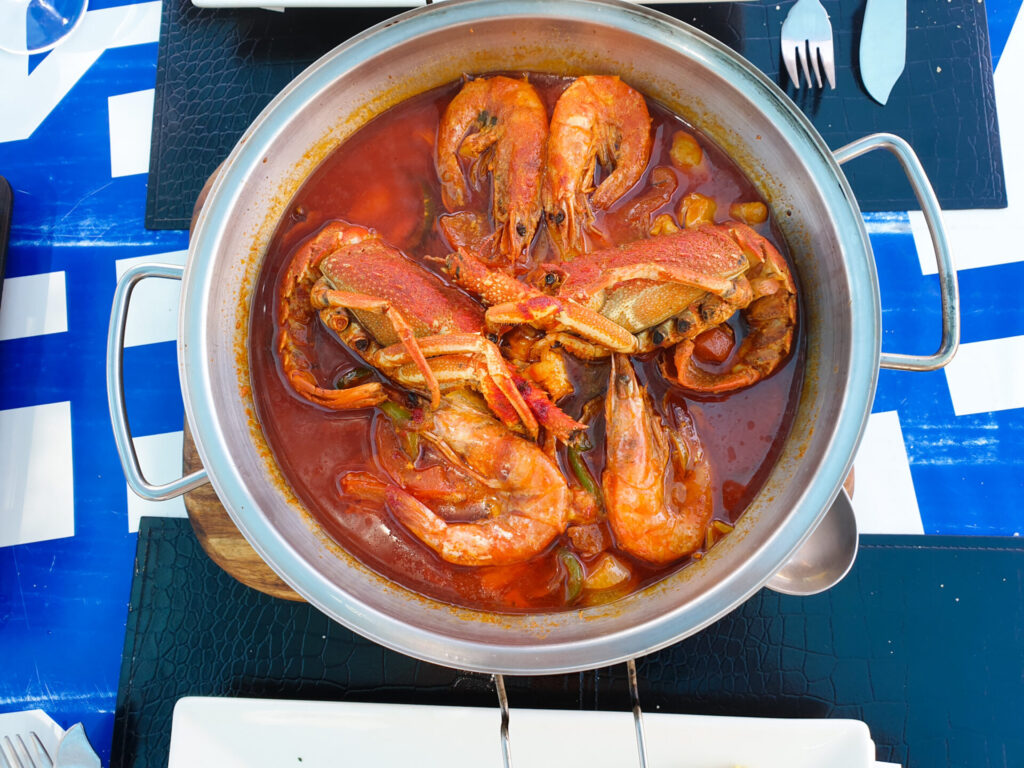
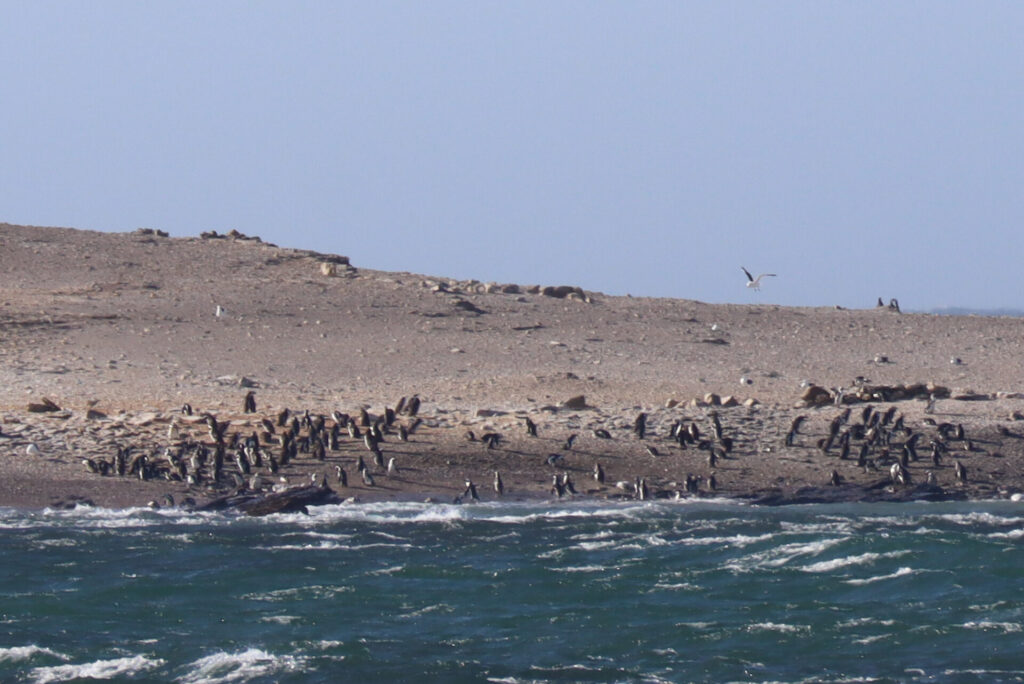
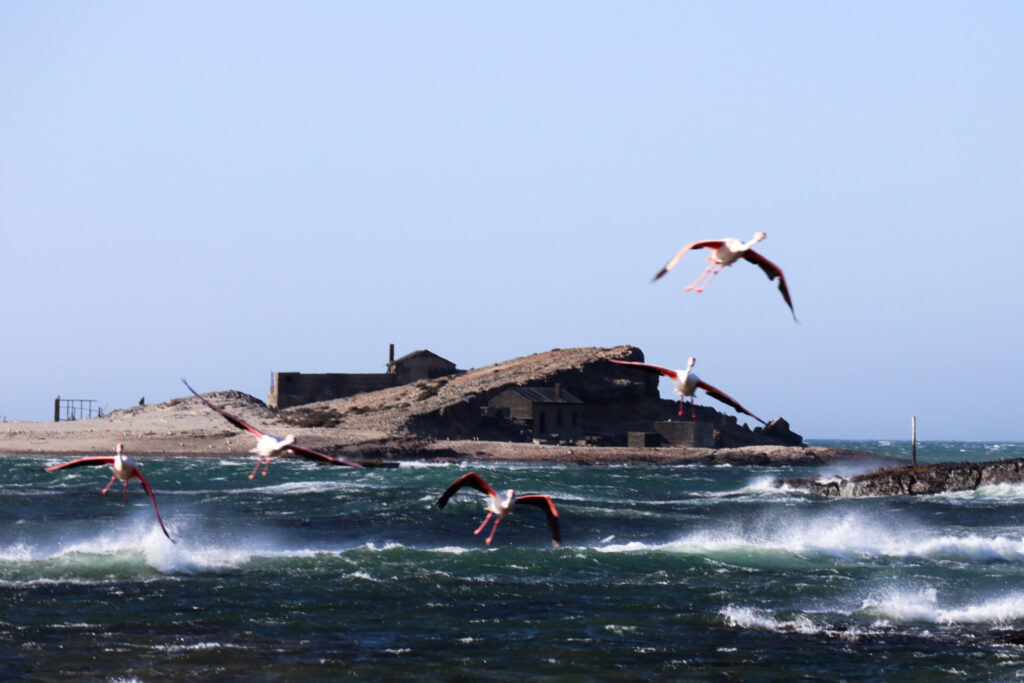
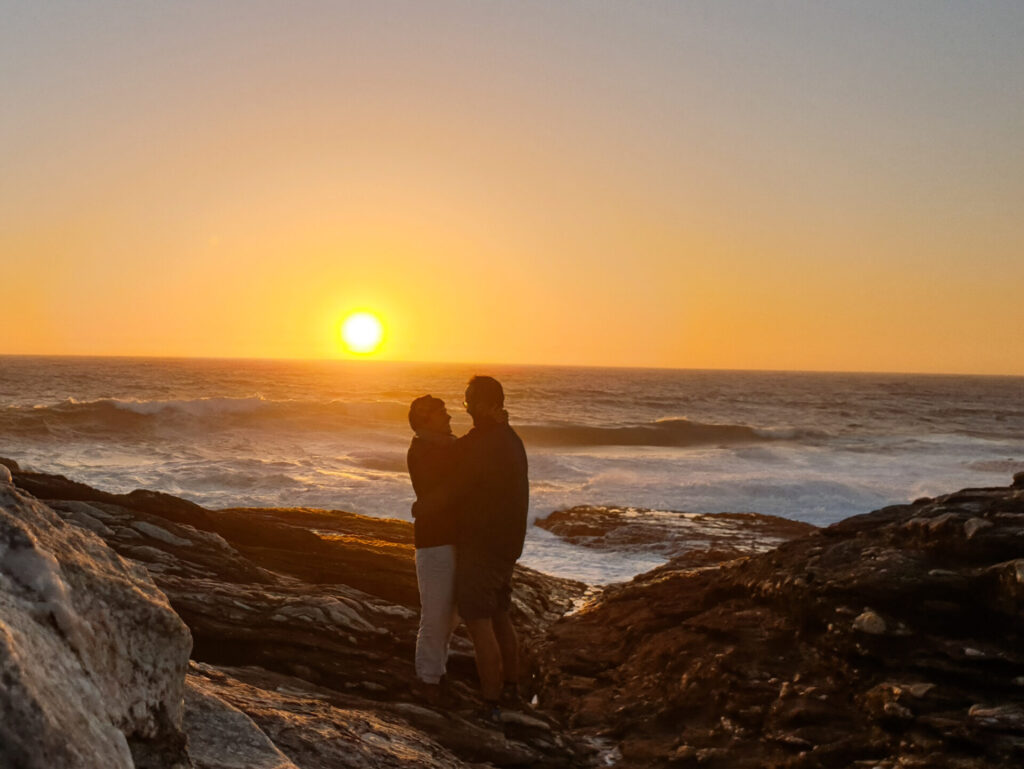

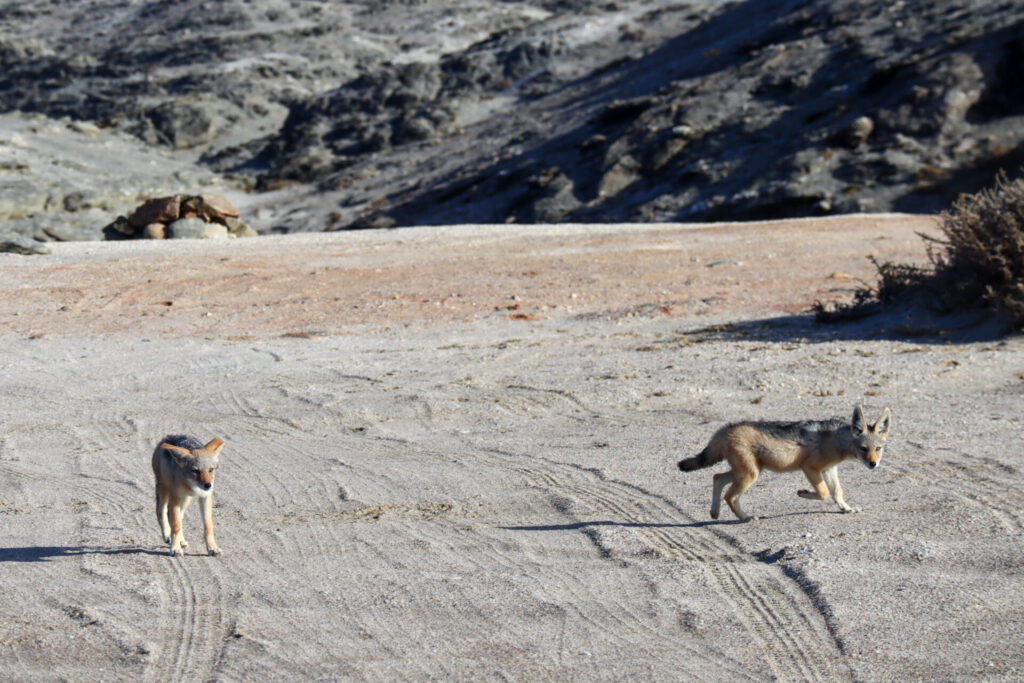
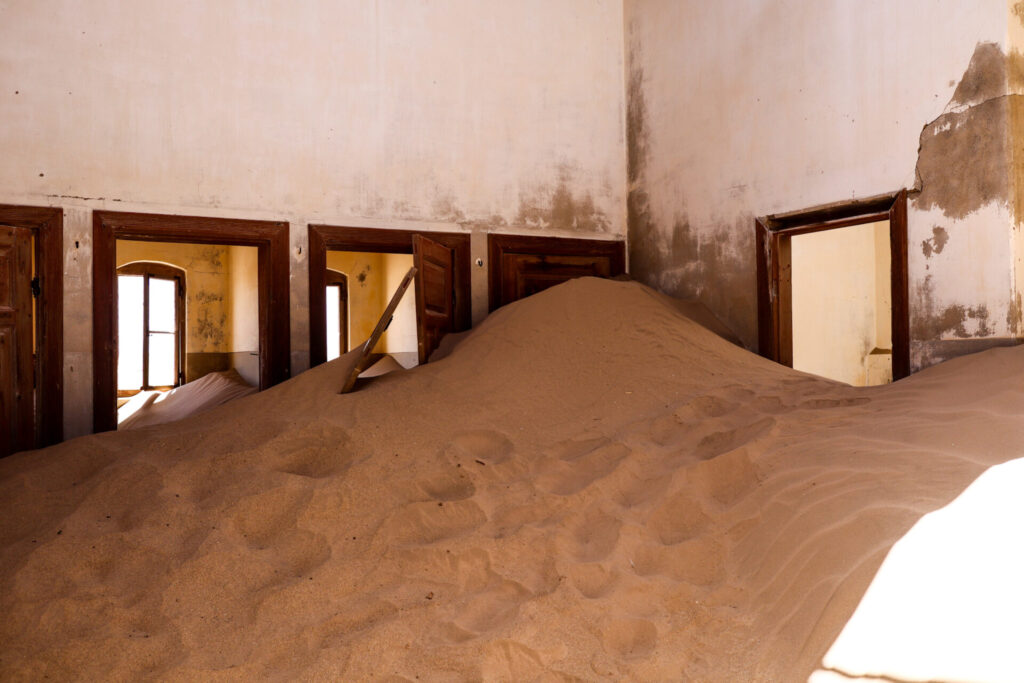

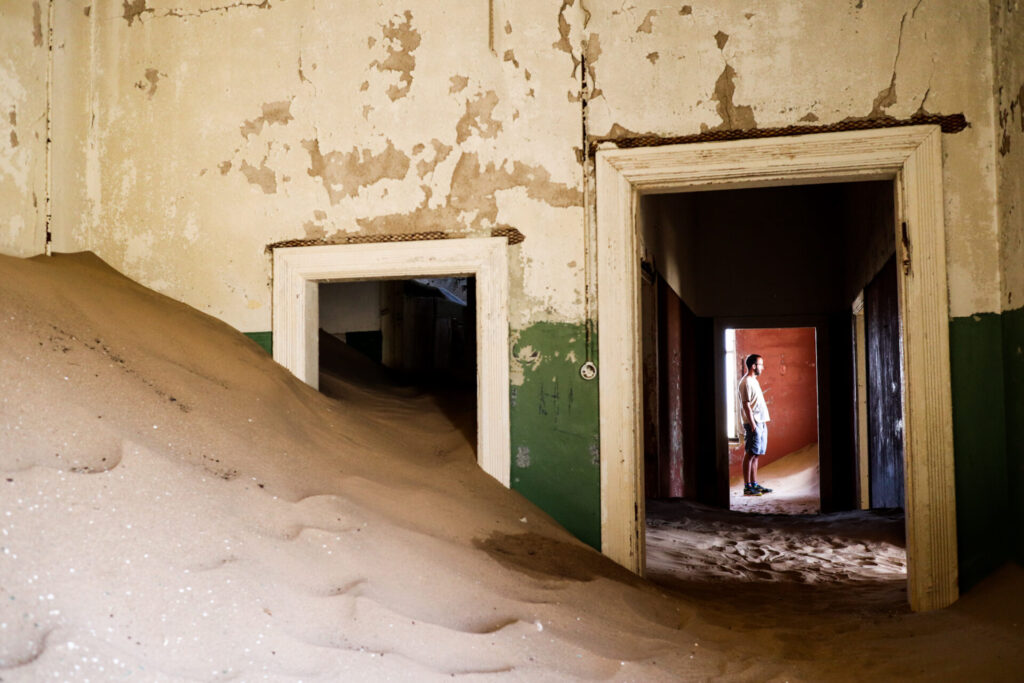
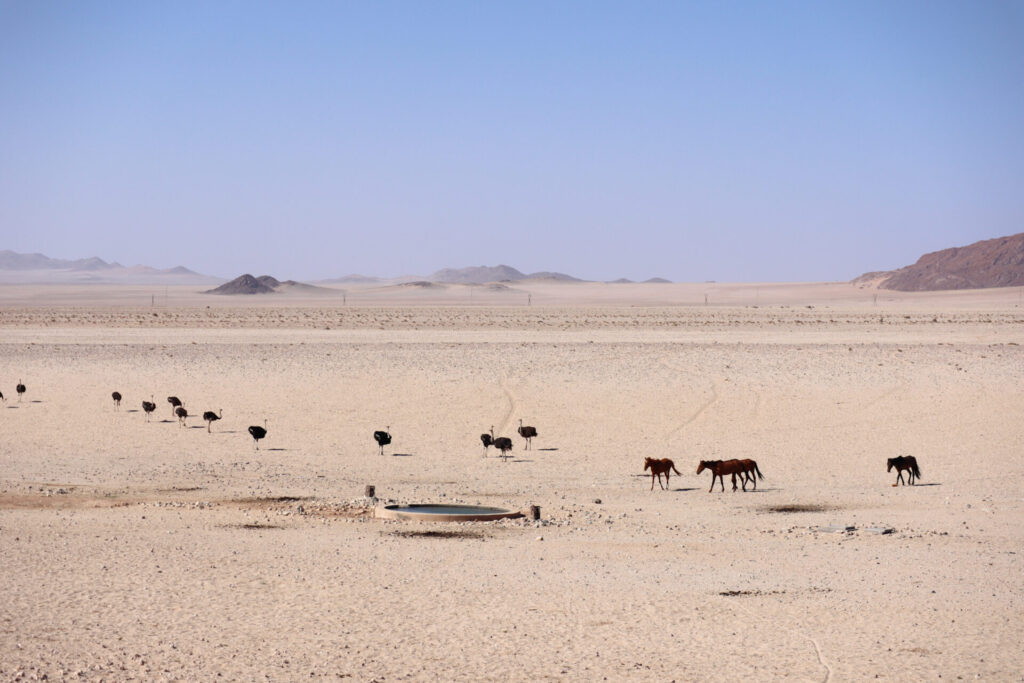
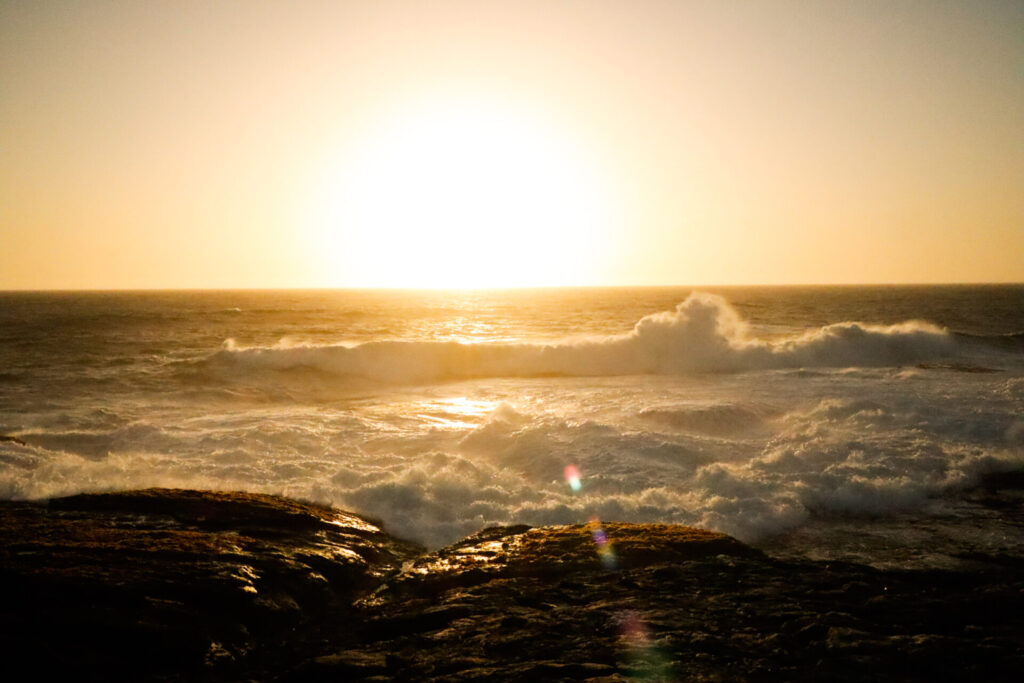


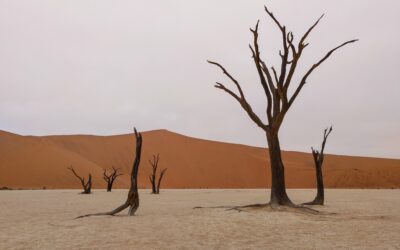
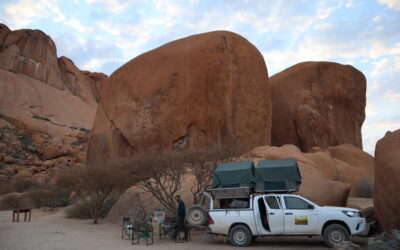
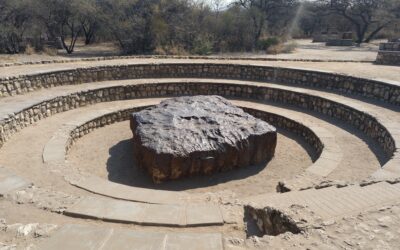
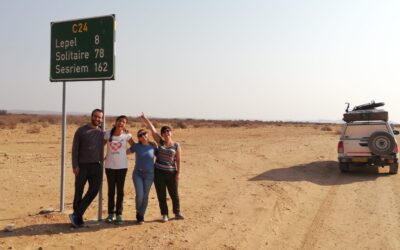

0 Comments